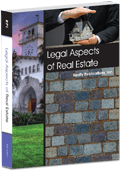Vacant properties are a lure for aspiring adverse possessors. The method by which property can be “stolen” is known as adverse possession.
Adverse possession exists for two primary reasons:
- to encourage full use of land; and
- to eliminate conflicts in title after a prescribed time period has passed.
While it is possible to “steal” the rights of ownership to real estate, very specific requirements need to be fulfilled in order to do so successfully – that is, if the would-be adverse possessor is not first caught trespassing and ejected.[See RPI e-book Legal Aspects of Real Estate Chapter 23]
Adverse possession criteria
Perfecting ownership by an adverse possession claim requires:
- a color of title or claim of right to title;
- actual, notorious and open possession;
- hostile, adverse and exclusive use;
- continuous and uninterrupted possession for five years; and
- payment of current and delinquent real estate taxes and assessments. [Gilardi v. Hallam (1981) 30 C3d 317]
Related Video: Title by Claims of Adverse Possession
Click here for more information on this topic.
Color of title or claim of right
Two distinct types of adverse possession claims exist:
- color of title, which is a claim of ownership based on a (typically defective and unenforceable) written instrument [Calif. Code of Civil Procedure §322]; and
- claim of right, which is a claim of ownership made without any documentation, except possession and payment of taxes. [CCP §324]
Actual, notorious and open possession
Adverse possessors are required to show they have been in actual possession of the property to which they are claiming ownership. They are to demonstrate actual possession of the property by:
- surrounding the property with a substantial, protective enclosure;
- cultivating the property; or
- improving the property. [CCP §325]
Additionally, the owner of the property against which the adverse possession claim is made needs to be on notice of the adverse possession. This notice may be either:
- actual, meaning the owner is personally aware of the occupancy or claim against their land; or
- constructive, meaning a reasonable person would know the adverse possessor appears to hold some interest in the property due to their occupancy. [Myran v. Smith (1931) 117 CA 355]
Hostile and adverse use
Hostile and adverse use is established when:
- a document exists, purporting to vest title in the adverse possessor in conflict with the true title; or
- the adverse possessor uses the property without permission or consent from the legal owner.
Exclusive, continuous and uninterrupted use
To perfect any adverse possession claim, use of the property needs to be exclusive. If another person concurrently or intermittently uses the property without the consent of the adverse possessor, the adverse possession claim will be defeated. [Laubisch v. Roberdo (1954) 43 C2d 702]
However, the occasional use of the property by the public (i.e., for recreational activities, as a right of way, etc.) will not affect an adverse possession claim. [Webber v. Clarke (1887) 74 C 11]
The adverse possessor is to also occupy the property continuously for at least five years in order to acquire title through adverse possession. [CCP §325]
The continuous possession under a claim of right needs to encompass a constant, definable portion of the property. A claim-of-right possessor who uses different portions of a property at different times for a total of five years will not satisfy the continuity requirement. [Zimmer v. Dykstra (1974) 39 CA3d 422]
Want to learn more about this topic? Click an image below to download the RPI book cited in this article.
This article was originally posted [December, 2012 of Protect yourself against adverse possession], and has been updated.
















Should someone believe there is a threat to their title (adverse possession, encroachment, liens) it’s best to seek legal advice from a proper attorney. Most Title Insurance companies generally will not defend against a adverse possession case. Which leaves filing for a quite title hearing to help clear the title of claims/encumbrances. These cases can be very complicated so legal representation is a very good idea!
My client is experiencing Hostile and adverse use on the roof of her town house. The town house next door, which sits higher then hers, decided to break through an exterior wall and set up a roof top garden on her units roof! Because of ceiling leaks, (tenant complained & moved-out) she, owner would never have known the neighbors did this. So, according to the city the property is in, the Burden of Proof is on her to prove she did not give them permission to use her roof! The neighbor, by the way, is the president of the HOA! So, as her Realtor, in my eyes, this is premeditated hostile adverse possession and elder abuse. My client is in her 70’s and depends on the rent to survive. The HOA president intimidates her, therefore, she is scared what they will do if she starts complaining about them walking on her roof!
I couldn’t have asked for a better article. Thank You!